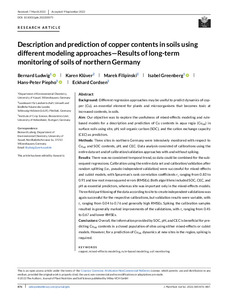| dcterms.abstract | Background: Different regression approaches may be useful to predict dynamics of copper (Cu), an essential element for plants and microorganisms that becomes toxic at increased contents, in soils. //
Aim: Our objective was to explore the usefulness of mixed-effects modeling and rule-based models for a description and prediction of Cu contents in aqua regia (CuAR) in surface soils using site, pH, soil organic carbon (SOC), and the cation exchange capacity (CEC) as predictors. //
Methods: Three sites in northern Germany were intensively monitored with respect to CuAR and SOC contents, pH, and CEC. Data analysis consisted of calibrations using the entire data set and of calibration/validation approaches with and without spiking. //
Results: There was no consistent temporal trend, so data could be combined for the subsequent regressions. Calibration using the entire data set and calibration/validation after random splitting (i.e., pseudo-independent validation) were successful for mixed-effects and cubist models, with Spearman's rank correlation coefficients rs ranging from 0.83 to 0.91 and low root mean squared errors (RMSEs). Both algorithms included SOC, CEC, and pH as essential predictors, whereas site was important only in the mixed-effects models. Three-fold partitioning of the data according to site to create independent validations was again successful for the respective calibrations, but validation results were variable, with rs ranging from 0.04 to 0.76 and generally high RMSEs. Spiking the calibration samples resulted in generally marked improvements of the validations, with rs ranging from 0.45 to 0.67 and lower RMSEs. //
Conclusions: Overall, the information provided by SOC, pH, and CEC is beneficial for predicting CuAR contents in a closed population of sites using either mixed-effects or cubist models. However, for a prediction of CuAR dynamics at new sites in the region, spiking is required. | eng |


